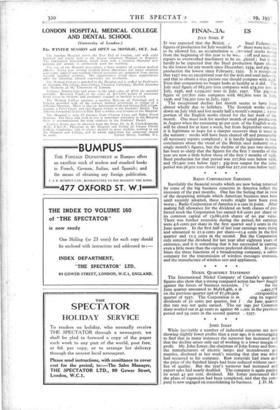FINANaAki FS JULY STEEL P IT was expected that the
British Steel Federati,n's figures of production for July would be 4,," there were holidays to be allowed for, an accumulation o. ;ainnrted stocks dating from the beginning of this year to be wort .1 off and necessary repairs to overworked machinery to be completed ; but it was hardly to be expected that the Steel production figure should be the lowest for any month since December, 1934, and pig-iron production the lowest since February, 1935. It is recognised that 1937 was an exceptional year for the iron and steel industry, and that to obtain a true picture one should compare with 1936. Even that comparison no longer looks as healthy as it did. The July steel figure of 683,200 tons compares with 9741100 tons in July, 1936, and 1,059,200 tons in July, 1937. The pig-iron figure of 507,800 tons compares with 665,600 tons in July, 1936, and 729,300 tons in July, 1937. figures of production for July would be 4,," there were holidays to be allowed for, an accumulation o. ;ainnrted stocks dating from the beginning of this year to be wort .1 off and necessary repairs to overworked machinery to be completed ; but it was hardly to be expected that the Steel production figure should be the lowest for any month since December, 1934, and pig-iron production the lowest since February, 1935. It is recognised that 1937 was an exceptional year for the iron and steel industry, and that to obtain a true picture one should compare with 1936. Even that comparison no longer looks as healthy as it did. The July steel figure of 683,200 tons compares with 9741100 tons in July, 1936, and 1,059,200 tons in July, 1937. The pig-iron figure of 507,800 tons compares with 665,600 tons in July, 1936, and 729,300 tons in July, 1937.
The exceptional decline last month seems to have been almost wholly due to holidays. The Scottish works closed down on July 16th and lost nearly half a month's output ; a pro.. portion of the English works closed for the last week of the month. One must look for another month of small production in August when the remaining 90 per cent. of the English works will be closed for at least a week, but from September onwards it is legitimate to hope for a sharper recovery than is usual in the autumn : stocks will have been cleared off and presumably all necessary repairs completed ; it is hardly legitimate to base conclusions about the trend of the British steel industry on a single month's figures, but the decline of the past two months has been so sharp that the figures for the first 7 months of this year are now a little below those of the first 7 months of 1936. Steel production for that period was 107,800 tons below 1936, and 787,900 tons below 1937 ; pig-iron output for the same period was 98,900 tons above 1936 but 227,100 tons below 1937.
RADIO CORPORATION EARNINGS
Inevitably the financial results which are now being returned by some of the big business concerns in America reflect the recession of the past months. One has the feeling that in view of the despairing attitude which American business men have until recently adopted, these results might have been even worse ; Radio Corporation of America is a case in point. After making full allowance for the dividend on both classes of pre- ferred stock the Corporation has earned 6.6 cents per share on its common capital of 13,881,016 shares of no par value. There was further recession during the period, for earnings were 4.6 cents per share in the first quarter and 2 cents in the June quarter. In the first half of last year earnings were rising and amounted to 21.9 cents per share-10.4 cents in the first quarter and 11.5 cents in the second. But the Corporation only entered the dividend list last year after eighteen years of existence, and it is something that it has succeeded in earning even a little more than the current preferred dividend. It com- bines the three functions of a broadcasting company, a cables company for the transmission of wireless messages overseas, and the manufacture of wireless sets and appliances.
NICKEL QUARTERLY STATEMENT
The International Nickel Company of Canada's quarterly figures also show that a strong rearguard action has been fought
against the forces of business recession. re- for the June quarter amounted to $6,618,486, a de s1495,278
on the previous quarter and of $7,580,909 - Jrresponding quarter of 1937. The. Corporation is m. _lung its regular dividends of 5o cents per quarter, but the June quarter this rate was not quite earned. The ear lags per Common share worked out at 42 cents as against 66 c....nts in the previous period and 94 cents in the second quarter . 1937.
* * * *
JOHN ISMAY
While inevitably a number of industrial concerns are now showing slightly lower profits than a year ago, it is encouraging to find that in many instances the turnover has increased and that the decline arises only out of working to. a lower margin of profit. Mr. John Ismay, the chairman of Johp Ismay and Sons, the manufacturers of electric lamps and incandescent gas mantles, disclosed at last week's meeting that that was what had occurred to his company. Raw materials had risen and the price of the finished lamps had been reduced without sacri- fice of quality. But the year's turnover had increased and export sales had nearly doubled. The company is again paying its usual 45 per cent. dividend. Mr. Ismay announced that the plans of expansion had been completed, and that the com- pany is now engaged on consolidating its business. J. D. M.






































 Previous page
Previous page